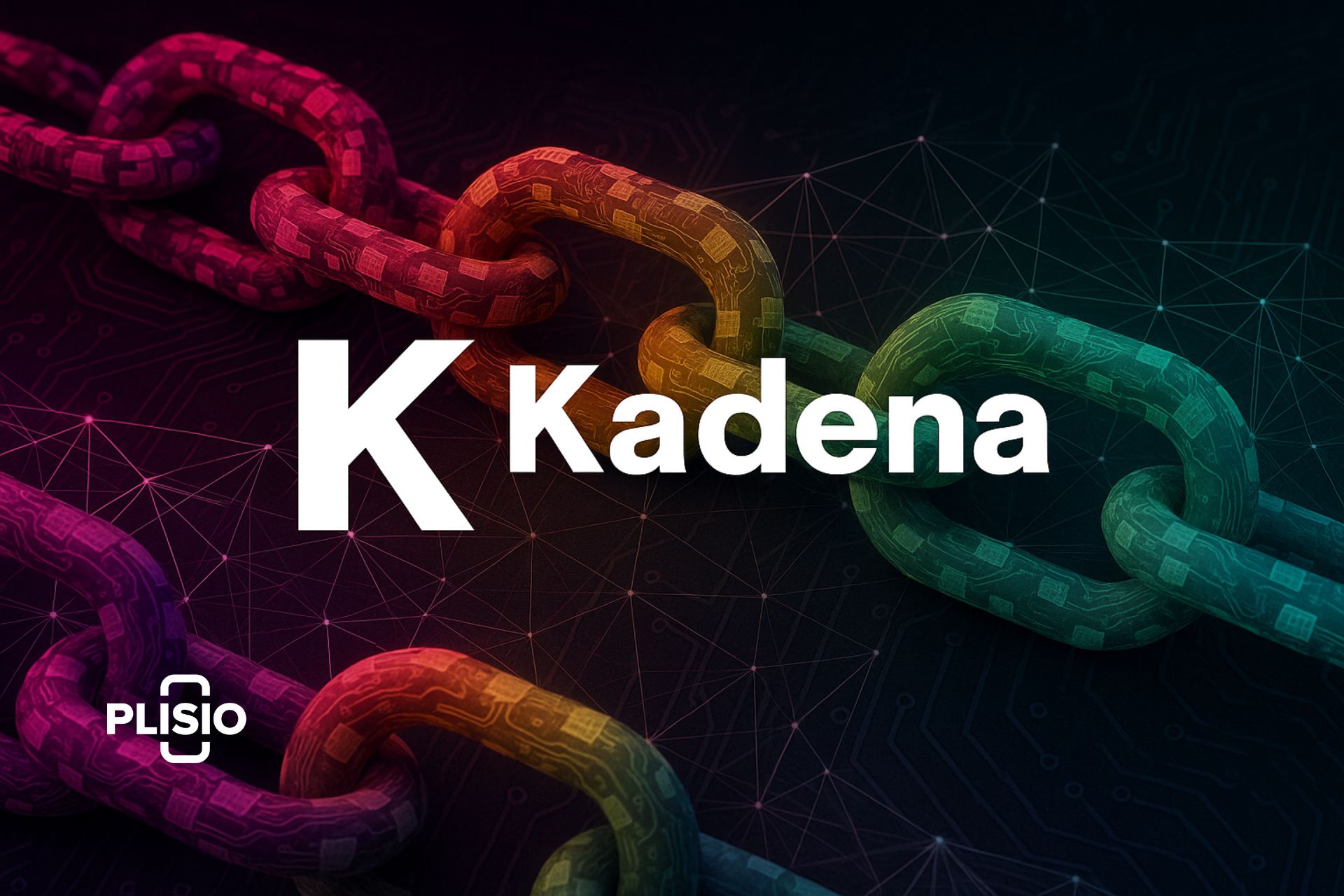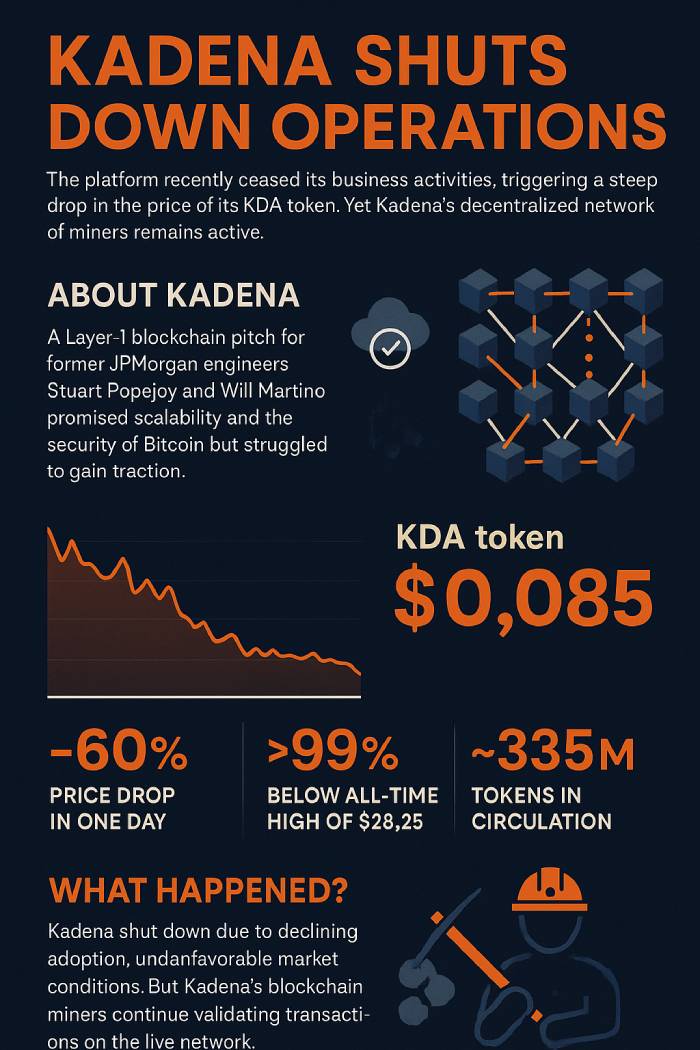Why Kadena’s Collapse Matters in Crypto

The global crypto landscape took a major hit when Kadena, a once-promising blockchain for business, announced it would shut down operations. The Kadena organization confirmed the immediate cease of all business operations and active maintenance of the Kadena blockchain, marking one of the most dramatic downturns in recent blockchain history. As of October 2025, the KDA token trades near $0.085, down nearly 99% from its all-time high of $28.25 during the 2021 bull run.
This event not only highlights the vulnerability of even the most advanced blockchain projects but also reflects broader challenges in the crypto markets—declining investor confidence, reduced liquidity, and overreliance on centralized teams.
Kadena Blockchain for Business: What Is Kadena (KDA)?
Kadena is a Layer-1 proof-of-work blockchain designed for real-world scalability, high throughput, and secure smart contract functionality. Founded by Stuart Popejoy and Will Martino, former JPMorgan blockchain engineers, Kadena sought to provide the security of Bitcoin with the flexibility of a smart contract language optimized for business operations.
At the heart of Kadena’s architecture is Chainweb, a directed acyclic graph structure of 20 parallel proof-of-work chains. This design allows Kadena to scale from one proof-of-work blockchain to many, achieving throughput of up to 480,000 transactions per second. This scalable design enables Kadena to handle mass adoption while maintaining decentralization and security.
The Kadena blockchain also introduced Pact, a smart contract language emphasizing formal verification and security. Pact’s design minimizes vulnerabilities common in Solidity, giving developers a more reliable platform for building enterprise-grade decentralized apps. With these innovations, Kadena aimed to support global financial systems and become a leader in adopting blockchains for business.
Why Kadena Shuts: What Happened to Kadena?
In October 2025, the Kadena team announced that the organization behind the Kadena blockchain is winding down and ceasing operations due to unfavorable market conditions. The official statement acknowledged that the organization is no longer able to continue business operations amid falling liquidity, developer attrition, and declining adoption.
Despite a $100 million ecosystem grant launched in 2022, less than a third was distributed, as developer interest waned. The trading volume for the KDA token fell to just $5–7 million daily, a sharp decline from its $150 million all-time high. By mid-2025, the number of active wallets dropped below 45,000. With market conditions worsening, maintaining business activity and active maintenance became unsustainable.
Analysts believe that Kadena struggled not because of its technology, but due to weak market traction, delayed enterprise adoption, and insufficient marketing in a highly competitive blockchain environment.

Kadena Shuts Down Operations: Official Announcement and Market Reaction
The Kadena organization issued its announcement on October 21, 2025, stating:
“We regret to announce that the Kadena organization is no longer able to continue business operations and will be ceasing all business activity and active maintenance of the Kadena blockchain immediately.”
The organization behind the Kadena blockchain blamed unfavorable market conditions, emphasizing that while corporate activity would cease, Kadena’s infrastructure is decentralized and built for mass adoption. The statement reassured the Kadena community that independent miners would continue to maintain the network:
“The Kadena blockchain is not owned or operated by the company. Kadena’s unique infrastructure is decentralized, maintained by independent miners, and governed by the Kadena community.”
Public reactions were mixed. Prominent voices in the crypto community expressed disappointment, while others praised the transparency of the announcement. Social media discussions across X (formerly Twitter) and Reddit threads show both sadness and hope for future community governance.
KDA Token and Kadena Price Chart — 2025 Tokenomics and Market Data
Following the Kadena shuts down operations announcement, the KDA token saw one of its steepest declines in history. As of October 2025:
- Market Cap: ~$29 million
- Circulating Supply: ~335 million KDA
- Total Supply: 1 billion KDA
- Locked Tokens: ~83.7 million (until 2029)
- Remaining to be mined: ~566 million KDA
- 24h Trading Volume: ~$4.8 million
- Hashrate: ~2.4 PH/s (down 35% YTD)
The KDA price drop reflects declining investor confidence. Despite the organization behind Kadena ceasing operations, the Kadena blockchain continues to run through independent miners. However, the mining community has shrunk by over 50%, jeopardizing network stability.
Adding to this, Kadena markets on major exchanges like Binance and KuCoin have seen liquidity drop by 80% since 2023. Analysts warn that without community governance or renewed funding, Kadena risks further price chart deterioration.
Kadena Community Response and the Future of Decentralized Governance
The Kadena community has been vocal in attempting to preserve the project. Discussions about forming a Kadena DAO and enabling community governance and maintenance are underway. The Kadena team has offered to assist with technical transitions and release final node binaries to facilitate decentralization.
In the wider crypto ecosystem, Kadena’s collapse is being used as a cautionary example. Despite its scalable proof-of-work model and security of Bitcoin, its main limitation is adoption. The Kadena community now faces the challenge of turning the network into a community-driven protocol — similar to what happened with other abandoned cryptocurrencies like Terra Classic.
Lessons from Kadena’s Collapse — What’s Next for Blockchain for Business Kadena
The Kadena blockchain remains operational, demonstrating that its infrastructure is decentralized and built for mass adoption. However, the fall of the organization behind Kadena raises key lessons for blockchain for business projects:
- Technical innovation alone doesn’t guarantee success without strong community support.
- Sustainable business operations and liquidity management are vital for long-term viability.
- Community governance models must be planned early to ensure resilience during crises.
For now, Kadena’s live price hovers below $0.10, with analysts forecasting modest recovery only if the Kadena community successfully transitions to a decentralized leadership structure. The KDA token still holds potential utility within the Kadena blockchain, but investor sentiment remains cautious.
Conclusion — What Happened to Kadena and What It Means for Crypto
Kadena’s story is a powerful reminder that even the most scalable proof-of-work blockchain can fail if market conditions turn hostile and user adoption lags. Built to provide the security of Bitcoin while pushing the limits of smart contract performance, Kadena shuts down operations under financial pressure, not technological failure.
Still, the Kadena blockchain immediately remains alive — a testament to the strength of decentralization. Whether it becomes a model for community governance or a warning of corporate overreach will depend entirely on what the Kadena community does next. In an era where crypto prices fluctuate wildly, Kadena’s fall reinforces one truth: success in blockchain isn’t just about code — it’s about community, confidence, and continuity.




